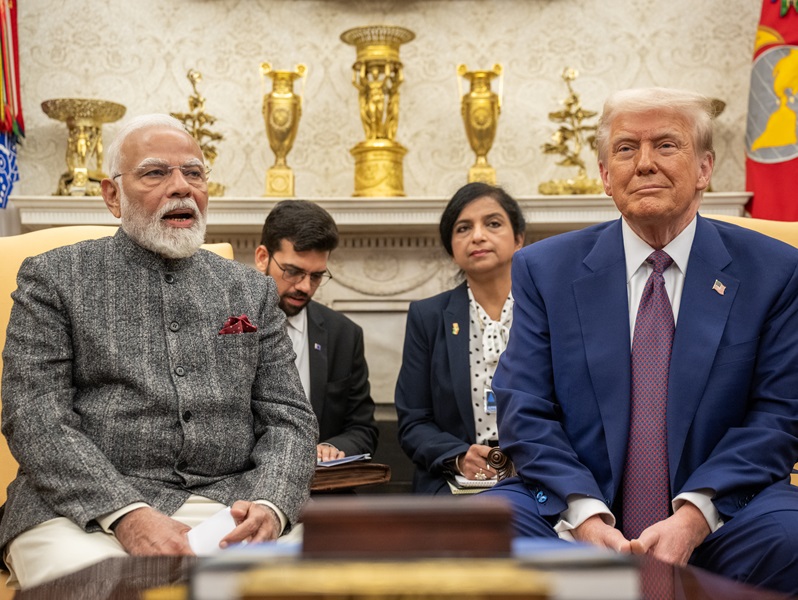.png)
Pakistan Moves Troops Forward, India Counters Misinformation Blitz
New Delhi rebuffs Pakistan’s claims of military success, shows imagery to prove Indian Air Force stations remain operational.
May 10, 2025 at 7:49 AM IST
Pakistan has begun moving troops into forward areas along the western frontier, signalling possible intent to escalate hostilities even as India reiterated its preference for non-escalation, provided it is reciprocated.
Indian armed forces remain in a high state of operational readiness after countering a wave of Pakistani drone intrusions, missile launches, and artillery shelling targeting both military and civilian infrastructure across Jammu and Kashmir, and Punjab since the early hours of Friday.
Briefing journalists in the capital on Saturday morning, senior Indian officials described the latest actions by Pakistan as a continuation of a “provocative and escalatory pattern” that began with coordinated drone swarms and loitering munitions deployed at more than two dozen sites earlier in the week.
India accused Pakistan of launching a multi-pronged offensive employing “multiple threat vectors”—including drones, high-speed missiles, and long-range weapons—targeting both airbases and civilian infrastructure.
Pakistan’s aggression, officials said, extended from the heights of Kashmir to the desert borders of Rajasthan, with simultaneous attacks reported in sectors such as Kupwara, Baramulla, Rajouri, and Akhnoor.
There were also high-speed missile attacks on Indian Air Force stations in Punjab after 1:40 AM Saturday, causing limited material damage and injuries to personnel in locations, including Udhampur, Pathankot, Adampur, and Bathinda.
Wing Commander Vyomika Singh and Colonel Sofiya Qureshi, who jointly addressed the media, said the Indian armed forces had successfully neutralised most of the threats and intercepted multiple aerial vectors.
Military Targets
Indian response operations were described as “swift and calibrated,” with the armed forces executing precision air strikes on Pakistani military targets located in Rafiqi, Murid, Chaklala, Rahim Yar Khan, Sukkur, Chuniya, and Pasrur. These strikes focused on technical infrastructure, command and control centres, radar installations, and ammunition depots.
“There was minimum collateral damage,” said Wing Commander Singh, underlining India’s stated objective of restraint. “This was a proportional response, carried out only on identified military targets.”
India also charged Pakistan with the deliberate targeting of civilian facilities, including the Medicare centre and school premises within airbase compounds at Srinagar, Awantipora, and Udhampur. According to Indian officials, such acts amounted to “irresponsible targeting of civilian infrastructure,” a violation of established wartime protocols.
The situation at the Line of Control has remained tense, with continued heavy exchanges of artillery and small arms fire in multiple sectors.
Officials confirmed that the Indian Army responded effectively to Pakistani shelling in areas such as Kupwara, Poonch, Rajouri, and Akhnoor. Notably, overnight shelling in Rajouri led to the death of the Additional District Development Commissioner, Raj Kumar Thapa, in what the government called a “deplorable and targeted attack on civil administration.”
Fabricated Narratives
As Pakistan continued to deploy military assets forward and ratchet up cross-border pressure, the parallel war of narratives has intensified.
India dismissed what it termed a “malicious misinformation campaign” being run by Pakistani state agencies. The campaign includes claims that Indian military facilities—such as the S-400 air defence system at Adampur, airbases at Suratgarh and Sirsa, the BrahMos missile base at Nagrota, and other critical infrastructure—had been targeted and damaged.
“These claims are entirely false,” said Foreign Secretary Vikram Misri in his concluding remarks at the briefing. “A tissue of lies peddled by the Pakistani state for obvious purposes.”
To support its assertions, the Indian government released images of Air Force installations at Suratgarh and Sirsa showing intact runways and infrastructure, timestamped May 10. Officials emphasised that all air force stations were operational and no critical systems had been taken out. The radar sites and surface-to-air defence installations claimed to have been neutralised by Pakistan remained functional, they said.
India further alleged that Pakistan had launched cyber and information warfare efforts to spread panic and sow discord between communities in Indian border states. “There is also a consistent attempt to create communal rifts in Punjab and Jammu and Kashmir, which we have noticed across multiple social media platforms,” Misri said.
Beyond the subcontinent, reactions to the deteriorating situation have begun to surface. China, in a cautious but clear message, urged both countries to “exercise calm and restraint,” according to a report by The Indian Express. A spokesperson for the Chinese foreign ministry stated that escalation between India and Pakistan would not serve regional stability and called for diplomatic engagement.
In a statement that drew rebuke from New Delhi, Pakistani officials alleged that Indian missiles had struck targets near the Sikh holy city of Amritsar and even in Afghanistan. India categorically denied these as “completely ludicrous and frivolous allegations.”
Foreign Secretary Misri added that “Afghans don’t need reminding which country has, in the last eighteen months, repeatedly targeted civilians in Afghanistan.”
India also responded sharply to televised remarks by the Pakistani military spokesperson, who mocked the Indian public’s criticism of its own government. “That is the hallmark of an open and functioning democracy and Pakistan’s unfamiliarity with that should not be surprising,” said Misri.
While India has called for restraint, officials underscored that any further escalation by Pakistan would be met with a firm and proportionate military response. “All hostile actions have been effectively countered and our forces remain in a high state of operational readiness,” said Colonel Qureshi.
As of Saturday morning, the Pakistani side had not made a formal offer of de-escalation. With Indian retaliatory strikes focused and confined to military assets, Islamabad must decide whether to step back from the brink or double down on its forward posture.
Also read:
India Counters Pakistan’s Drone Swarm With Precision Strike
New Rules Of Engagement Take Shape After Sindoor Strikes
India Must Wield Tax Protocols As A Strategic Deterrent Against Pakistan
Operation Sindoor



